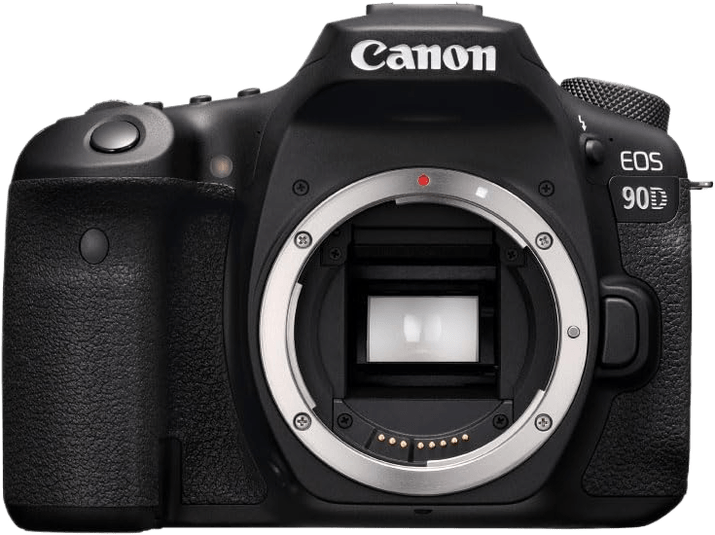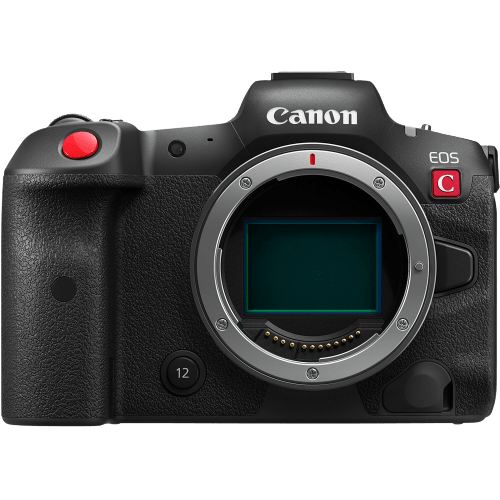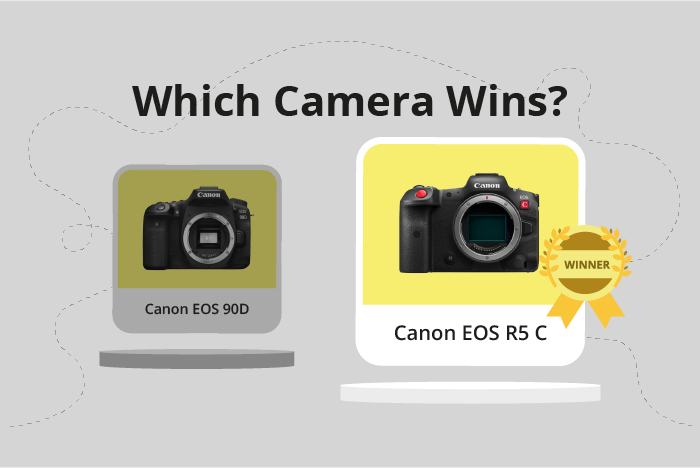Canon EOS 90D vs EOS R5 C Comparison
Canon EOS 90D

Canon EOS R5 C

The Canon EOS R5 C outperforms the Canon EOS 90D with a score of 87/100 compared to 67/100. Both cameras share similarities such as being released by Canon and having similar dimensions, with the EOS 90D measuring 141 x 105 x 77mm and the EOS R5 C at 142 x 101 x 111mm. The EOS R5 C excels with its mirrorless design and higher launch price of $4499, indicating a more advanced system. On the other hand, the EOS 90D is a DSLR with a lower launch price of $1199, making it more budget-friendly.
The EOS R5 C’s higher score shows its superior performance, while the EOS 90D’s lower score highlights its affordability. Both cameras cater to different needs and preferences, with the EOS R5 C being the better choice for professionals and the EOS 90D appealing to those on a budget.
Canon 90D vs R5 C Overview and Optics
The Canon EOS R5 C outperforms the Canon EOS 90D in optics, scoring 88 out of 100 compared to the 90D’s 62 points. Both cameras share some common specifications, including the CMOS sensor type and a range of compatible lenses. However, the R5 C excels in several areas, making it the superior choice in terms of optics.
The R5 C boasts a higher megapixel count of 45, compared to the 90D’s 33, allowing for greater detail and resolution in images. Additionally, the R5 C has a faster shooting speed of 20 frames per second, doubling the 90D’s 10 fps capability. This feature makes the R5 C more suitable for capturing fast-moving subjects or high-speed action.
Another advantage of the R5 C is its full-frame sensor size, which provides better low-light performance and a shallower depth of field compared to the 90D’s APS-C sensor. The R5 C’s sensor also has a significantly higher DXOMARK score of 97, compared to the 90D’s 58, indicating superior overall image quality. Furthermore, the R5 C uses the advanced Digic X processor, while the 90D employs the older Digic 8 processor.
The R5 C also includes built-in image stabilization, which the 90D lacks. This feature helps reduce camera shake and improve image sharpness, especially in low-light situations or when using longer focal lengths.
The 90D does have one advantage: it utilizes the Canon EF/EF-S lens mount, which offers a wider selection of lenses. However, the R5 C’s Canon RF lens mount is designed for mirrorless cameras and provides better performance with native RF lenses.
Considering these factors, the Canon EOS R5 C is the clear winner in terms of optics, offering higher resolution, faster shooting speeds, a superior sensor, and image stabilization. While the Canon EOS 90D may have a broader lens selection, its overall optical performance falls short of the R5 C’s capabilities.
Canon EOS 90D vs EOS R5 C Video Performance
The Canon EOS R5 C outperforms the Canon EOS 90D in video capabilities, scoring 100/100 compared to the 90D’s 91/100. Both cameras share some features, such as a maximum video frame rate of 120fps and built-in time-lapse functionality. However, the R5 C offers superior specifications, making it the clear winner in this comparison.
The most significant advantage of the R5 C is its 8K video resolution, which is twice the resolution of the 90D’s 4K capability. This means the R5 C can capture highly detailed and crisp footage, providing better video quality. In addition, the R5 C boasts a maximum video dimension of 8192 x 4320, compared to the 90D’s 3840 x 2160. This larger dimension enables the R5 C to produce stunning visuals with more clarity and depth.
On the other hand, the Canon EOS 90D still offers solid video performance with its 4K resolution and max video dimensions of 3840 x 2160. While not as impressive as the R5 C, these specifications are sufficient for most users and provide good video quality. The 90D’s 91/100 video score is still a high mark, indicating that it is a capable camera for video recording.
In conclusion, the Canon EOS R5 C is the superior camera for video capabilities, offering 8K resolution and larger video dimensions. This results in higher-quality footage and better overall performance. However, the Canon EOS 90D is still a strong contender with its 4K resolution and high video score. Ultimately, the choice between these two cameras depends on the user’s specific needs and priorities.
Canon EOS 90D vs EOS R5 C Features and Benefits
The Canon EOS R5 C wins the features comparison with a score of 87/100, while the Canon EOS 90D scores 83/100. Both cameras share several specifications, including a touchscreen, flip screen, absence of GPS, and the presence of WIFI and Bluetooth connectivity.
The EOS R5 C outperforms the EOS 90D in screen size and resolution. The R5 C’s screen measures 3.2 inches, while the 90D’s screen is 3 inches. Additionally, the R5 C’s screen resolution is higher at 2,100,000 dots, compared to the 90D’s 1,040,000 dots. These differences contribute to a better viewing and navigation experience on the R5 C.
The EOS 90D, despite having a lower feature score, still offers advantages. Its smaller screen size and lower resolution can make it a more compact and lightweight option for those prioritizing portability. Additionally, the difference in feature score is only 4 points, indicating that the 90D is still a strong contender in terms of features.
Considering the shared specifications and differences, the EOS R5 C is the superior camera in terms of features, particularly with its larger screen and higher resolution. However, the EOS 90D remains a viable option for those seeking a more compact camera without sacrificing too many features. Ultimately, the choice between these two cameras depends on the individual’s priorities and preferences.
Canon EOS 90D vs EOS R5 C Storage and Battery
The Canon EOS R5 C outperforms the Canon EOS 90D in storage and battery with a score of 68/100 compared to 48/100. Both cameras accept SD, SDHC, and SDXC (UHS-II compatible) memory cards. However, the R5 C offers two memory card slots, with one also supporting CFexpress B cards, while the 90D has only one slot.
The R5 C has a significant advantage with its USB charging capability, making it more convenient for on-the-go charging. On the other hand, the 90D has a longer battery life, providing 1300 shots compared to the R5 C’s 320 shots. Both cameras use similar battery types, with the 90D using the LP-E6N and the R5 C using the LP-E6NH.
Despite the shorter battery life, the Canon EOS R5 C’s additional memory card slot, wider range of compatible memory cards, and USB charging capability make it a better choice for storage and battery. The Canon EOS 90D, however, may still be a suitable option for those prioritizing longer battery life.
Canon EOS 90D vs EOS R5 C – Our Verdict
Are you still undecided about which camera is right for you? Have a look at these popular comparisons that feature the Canon EOS 90D or the Canon EOS R5 C:

